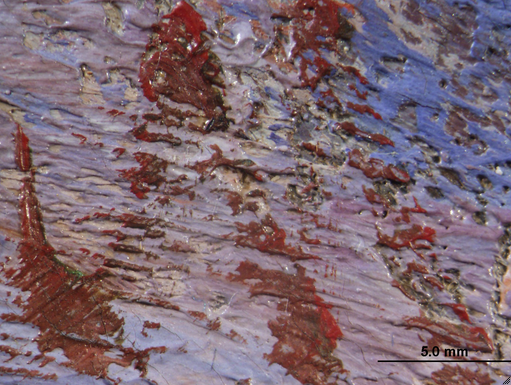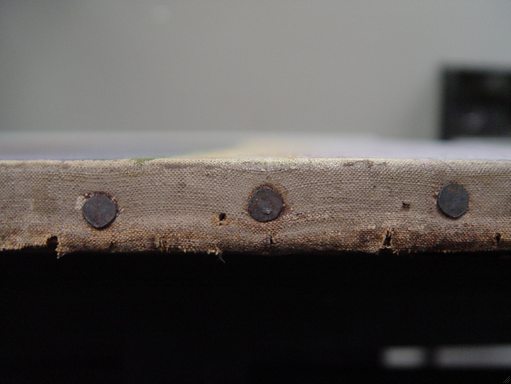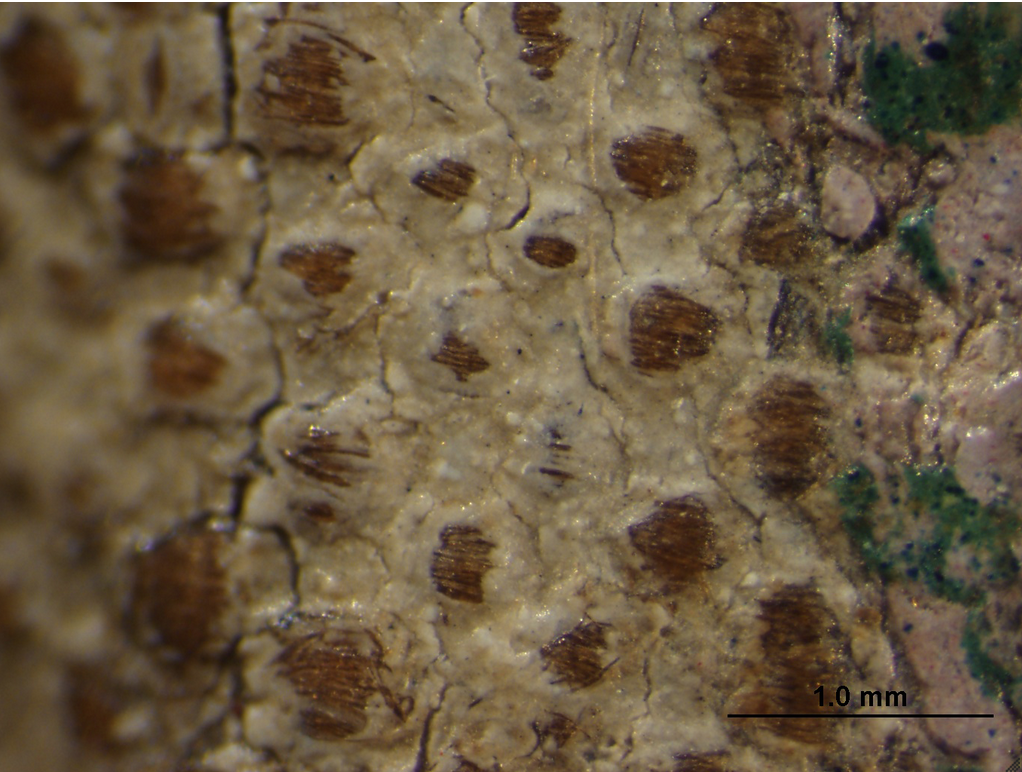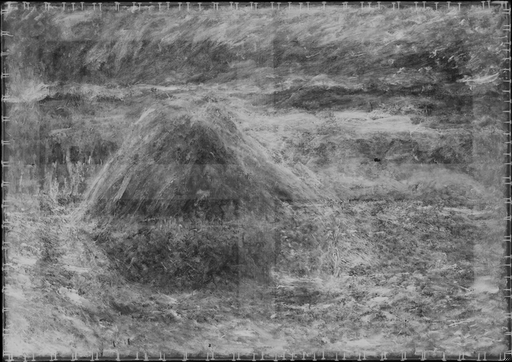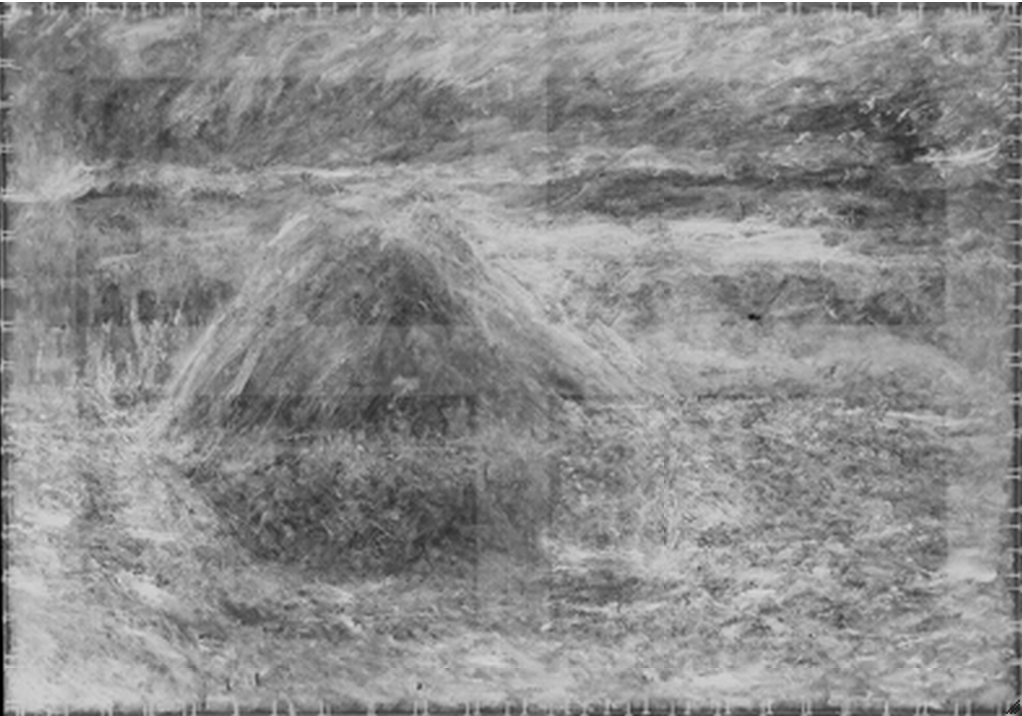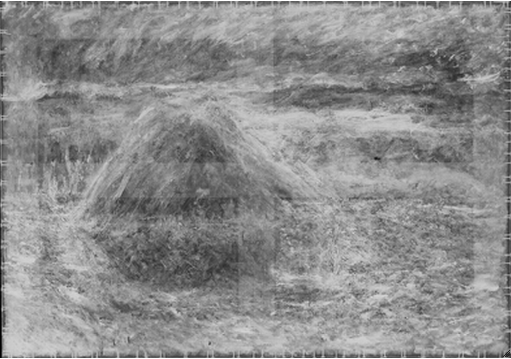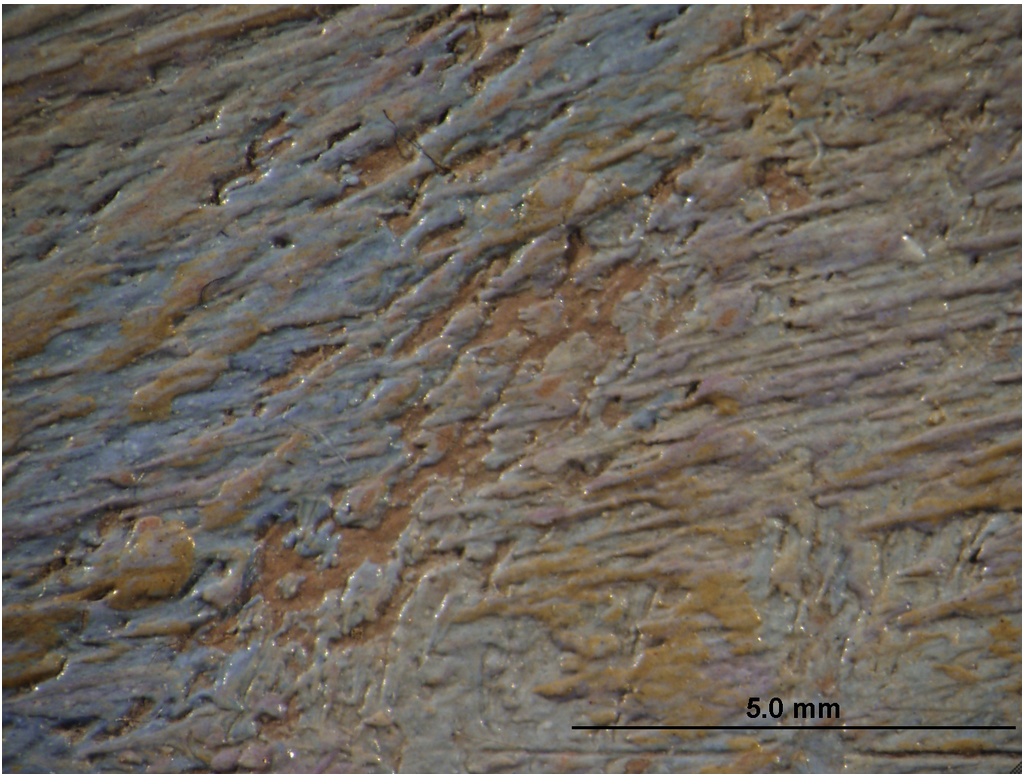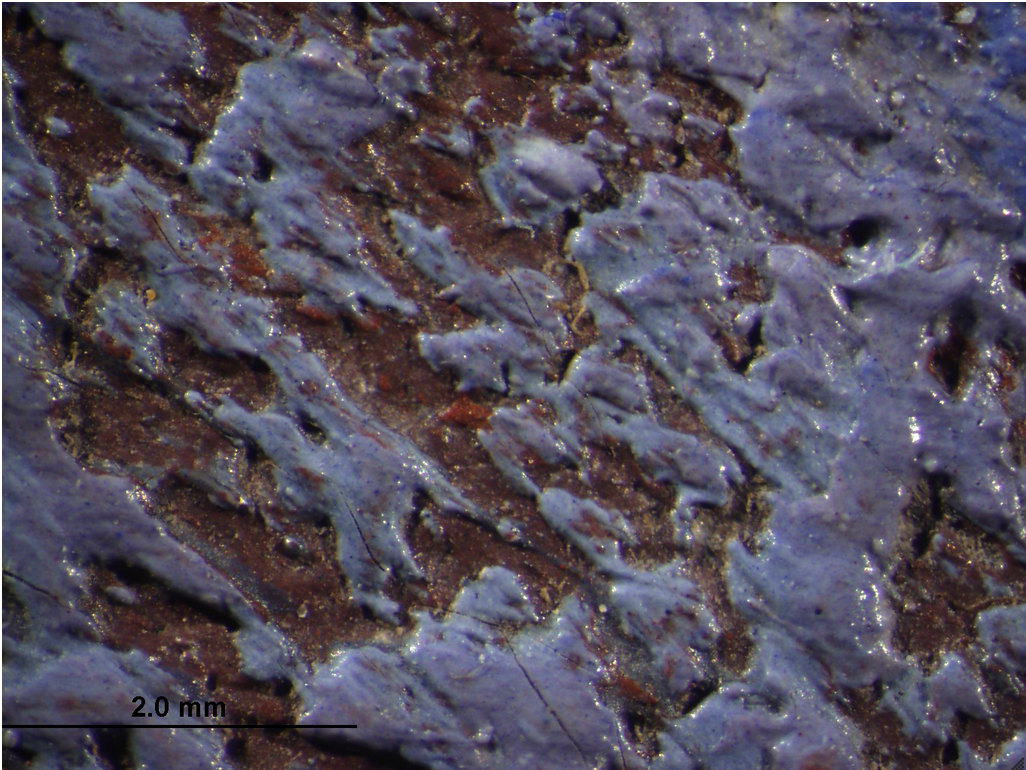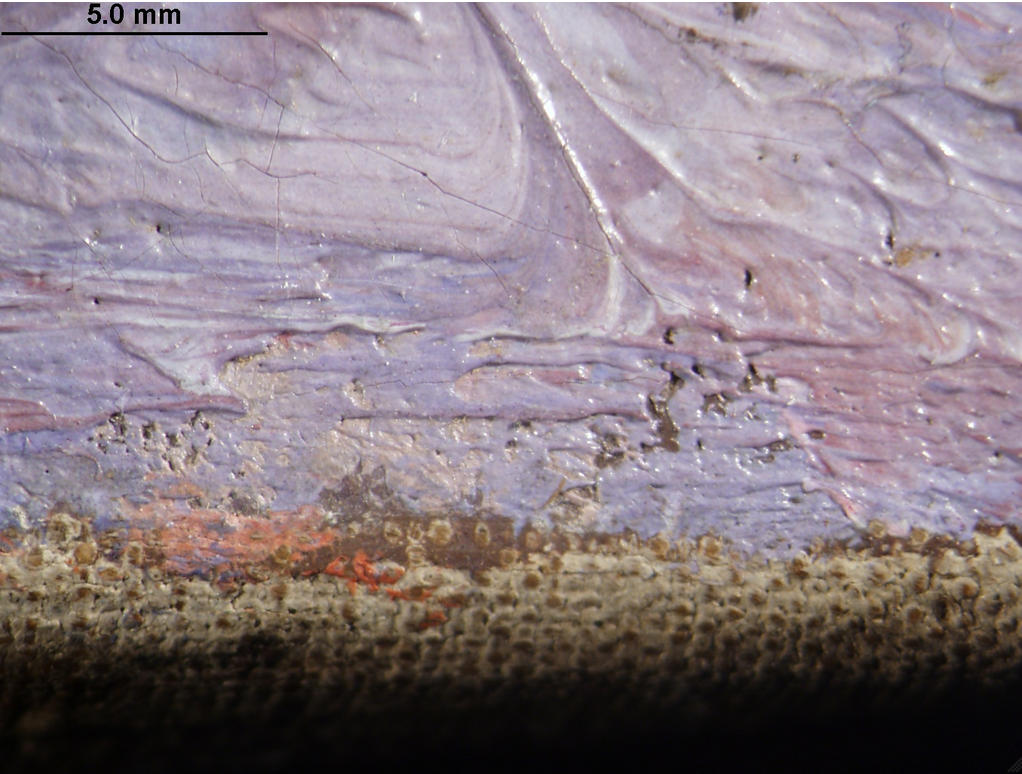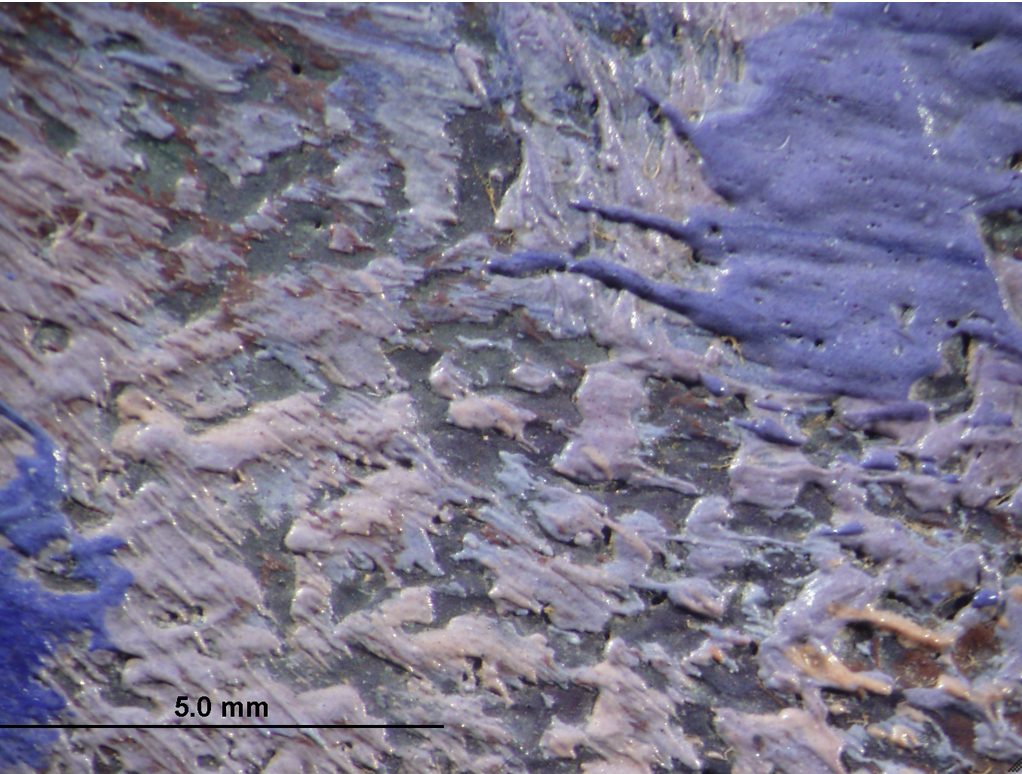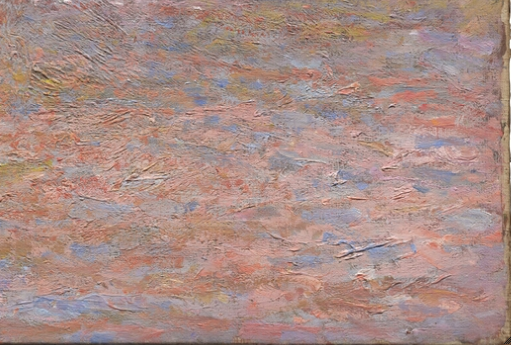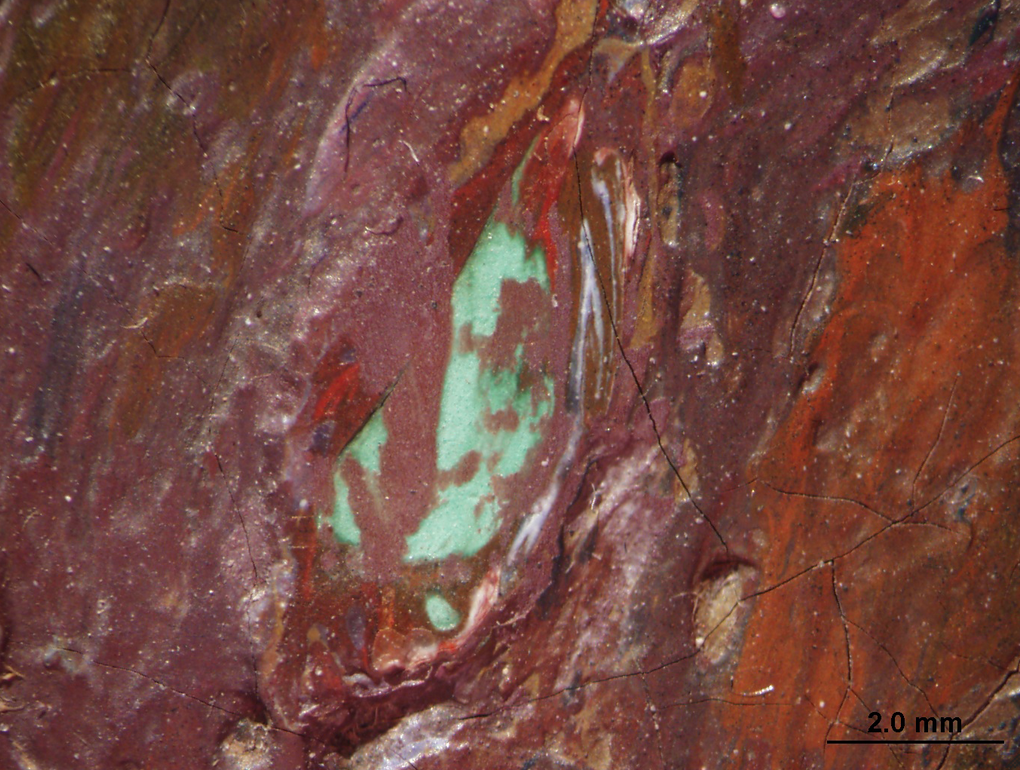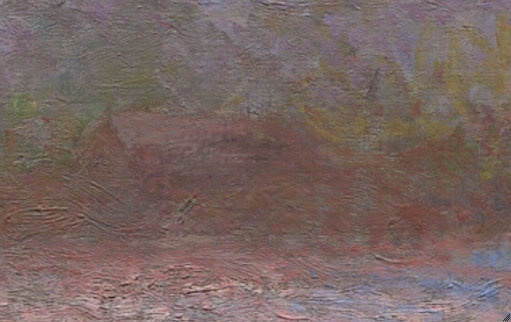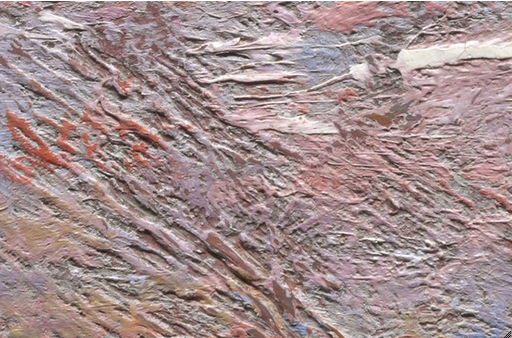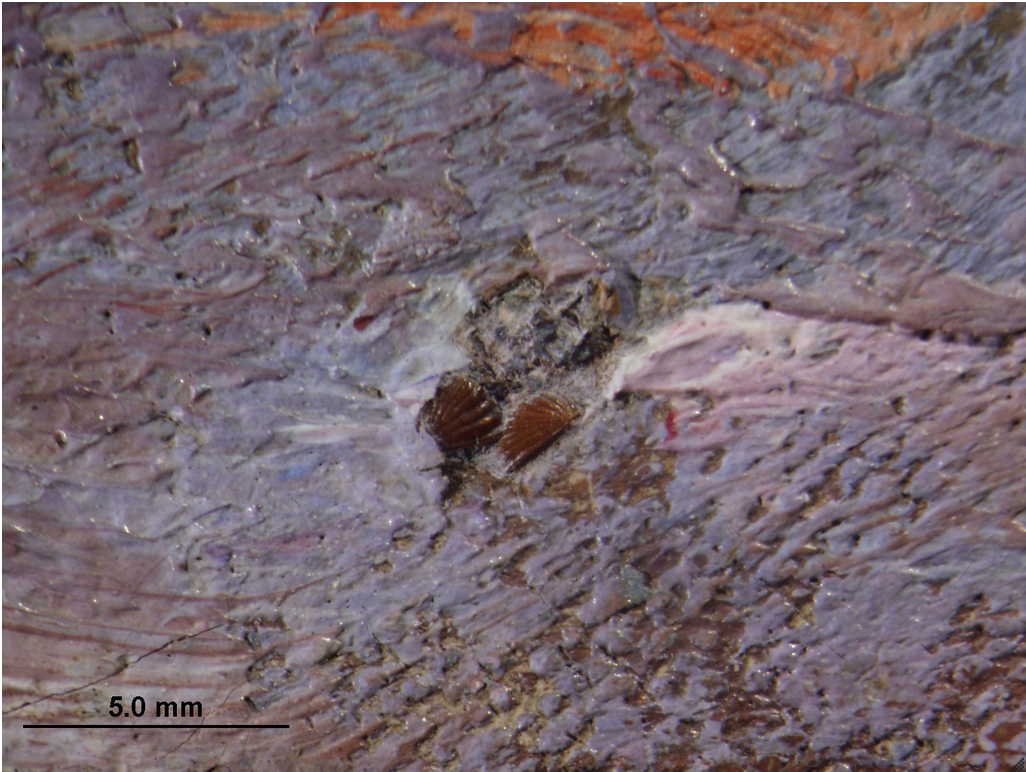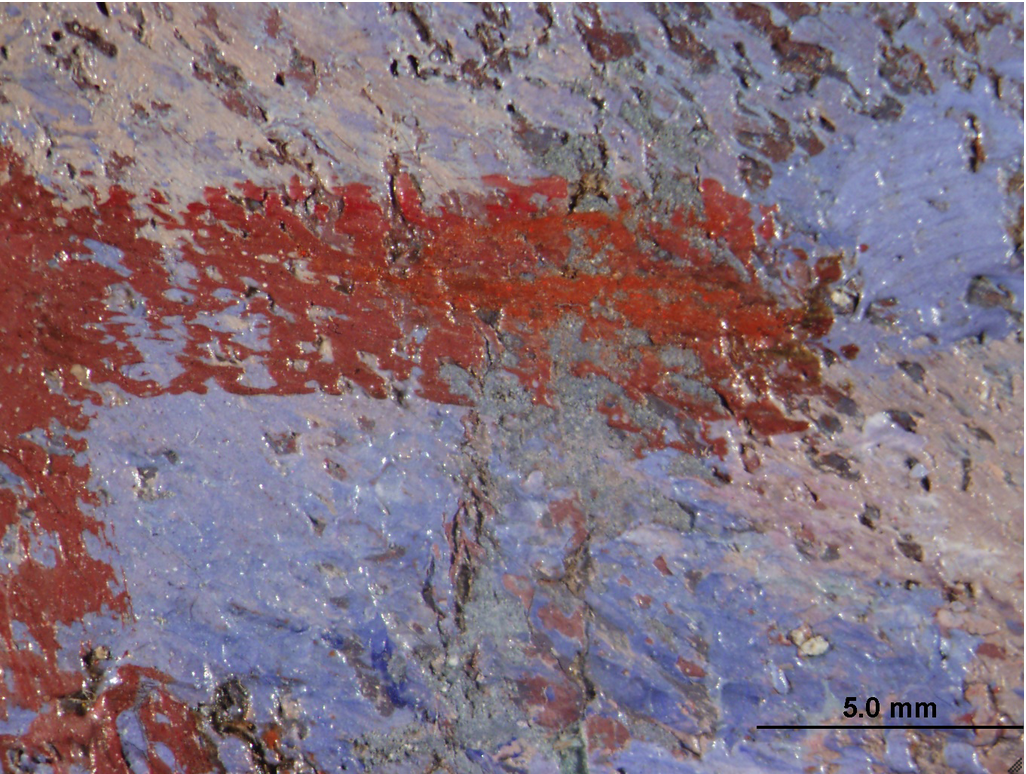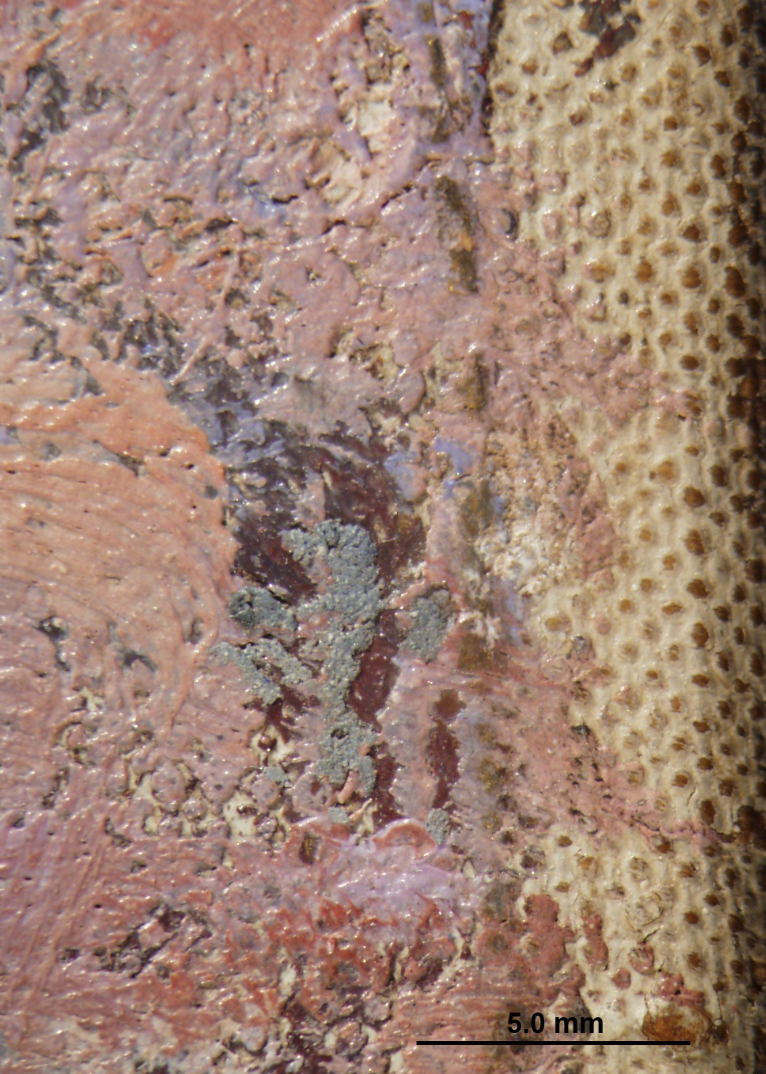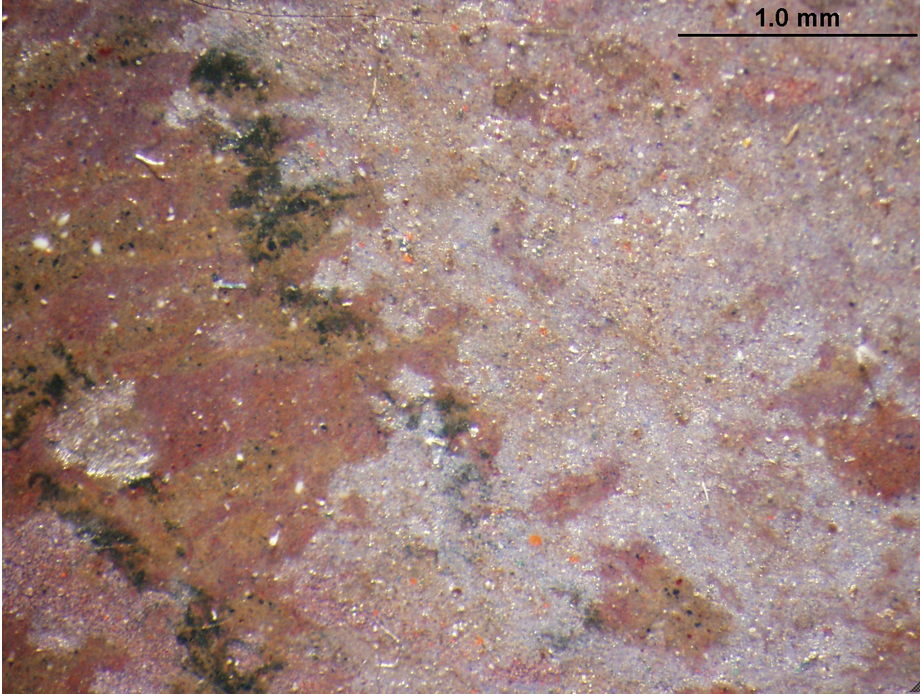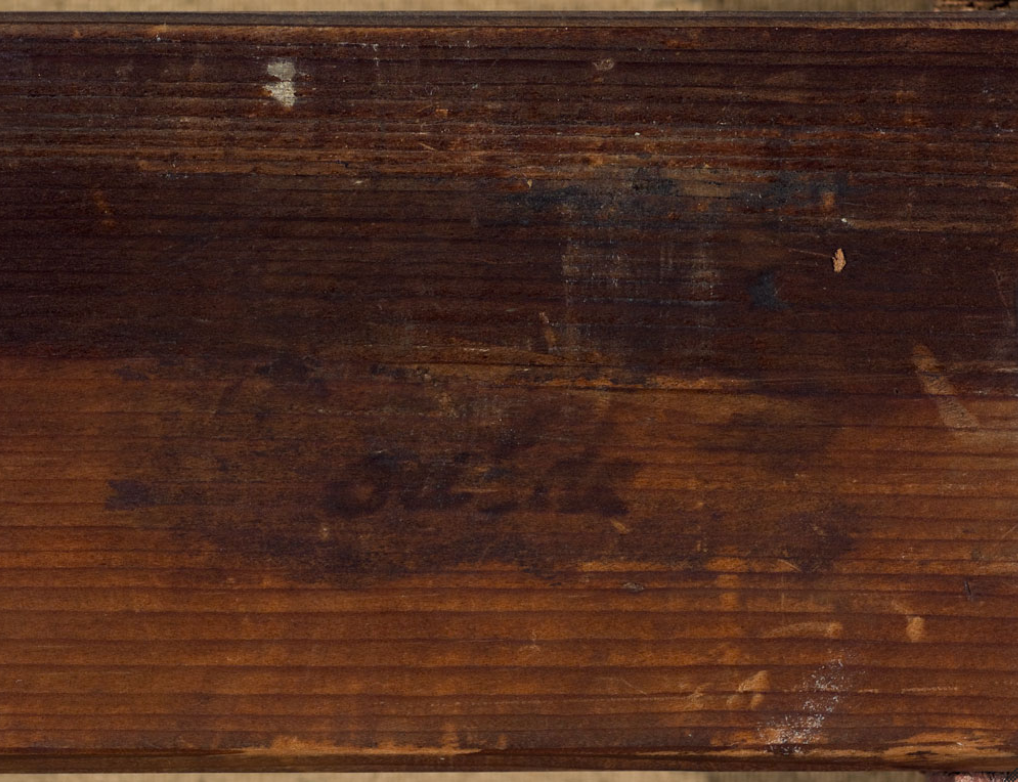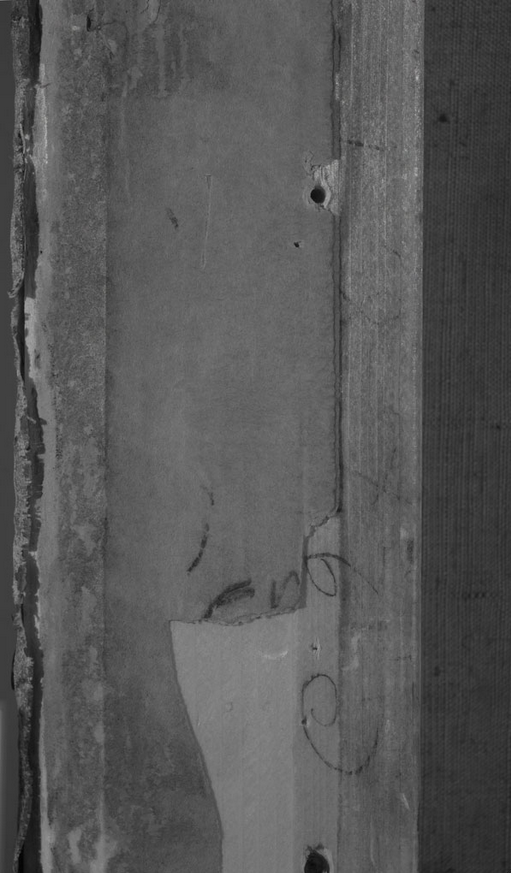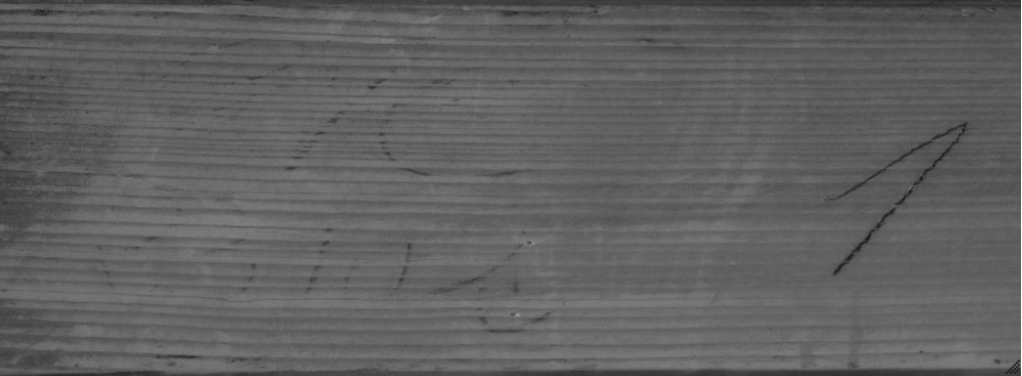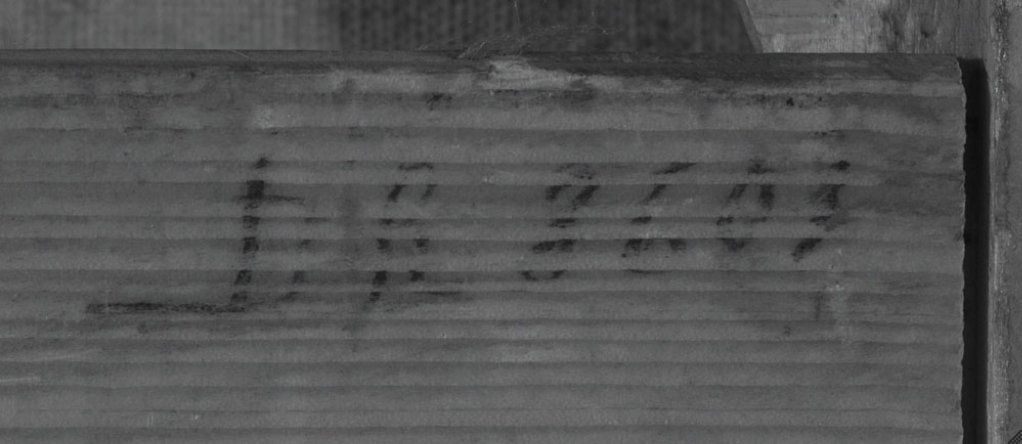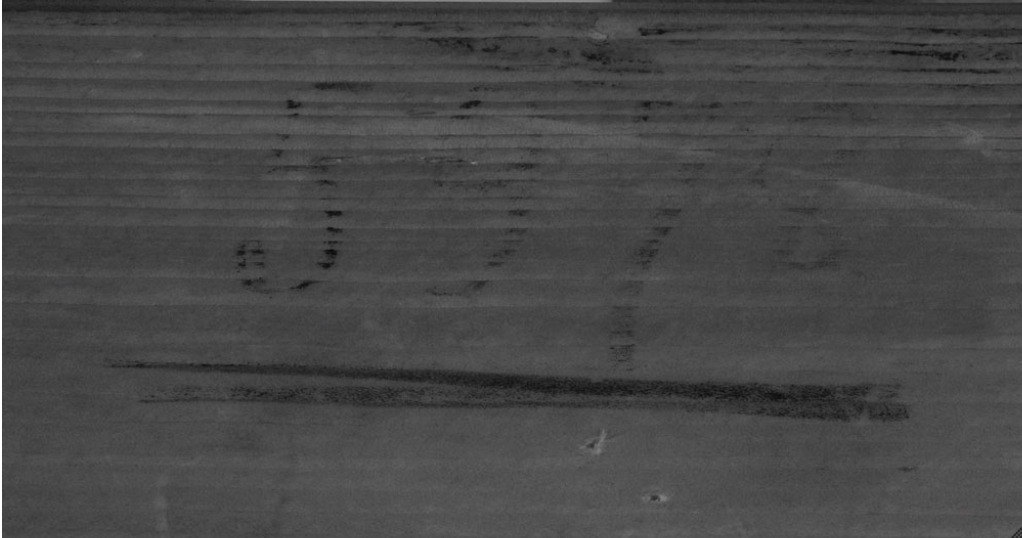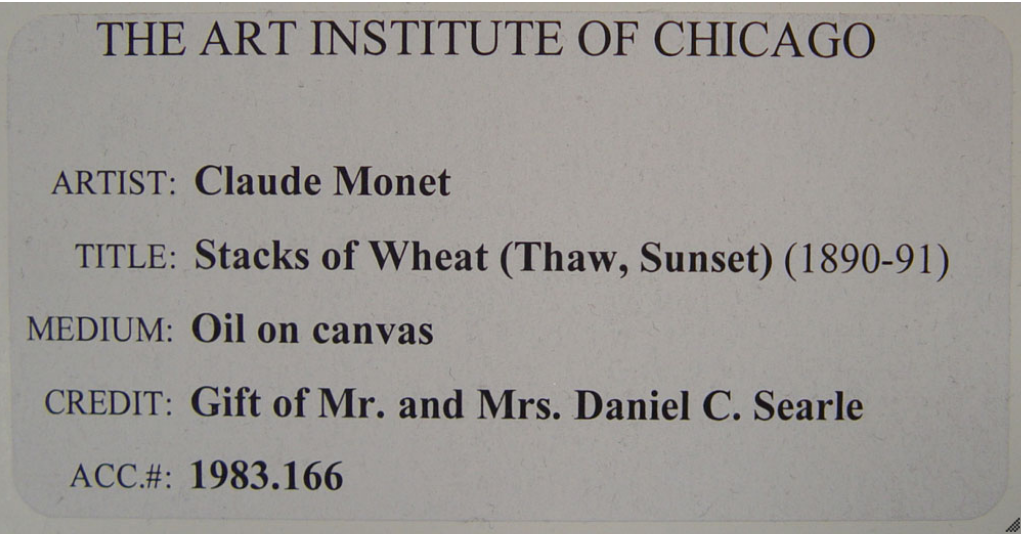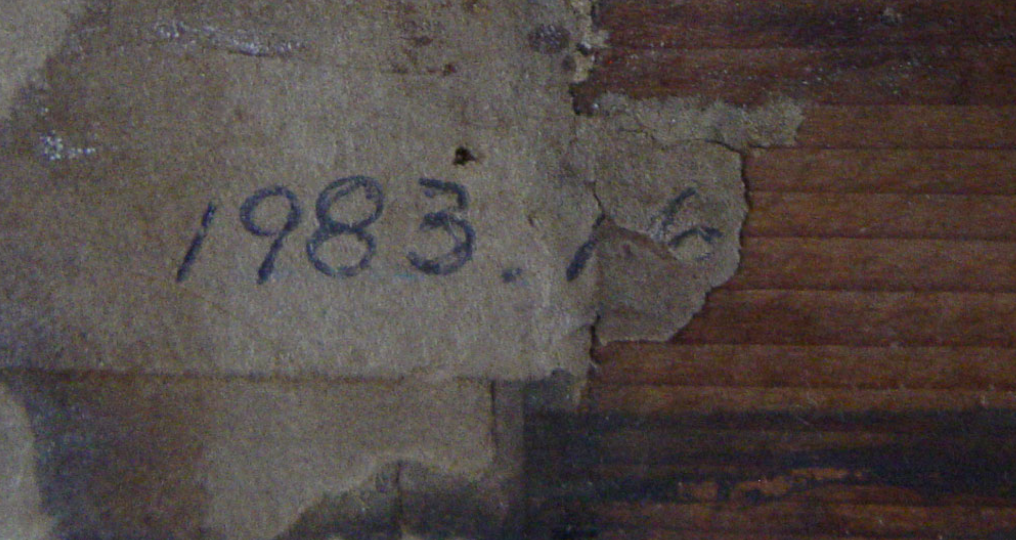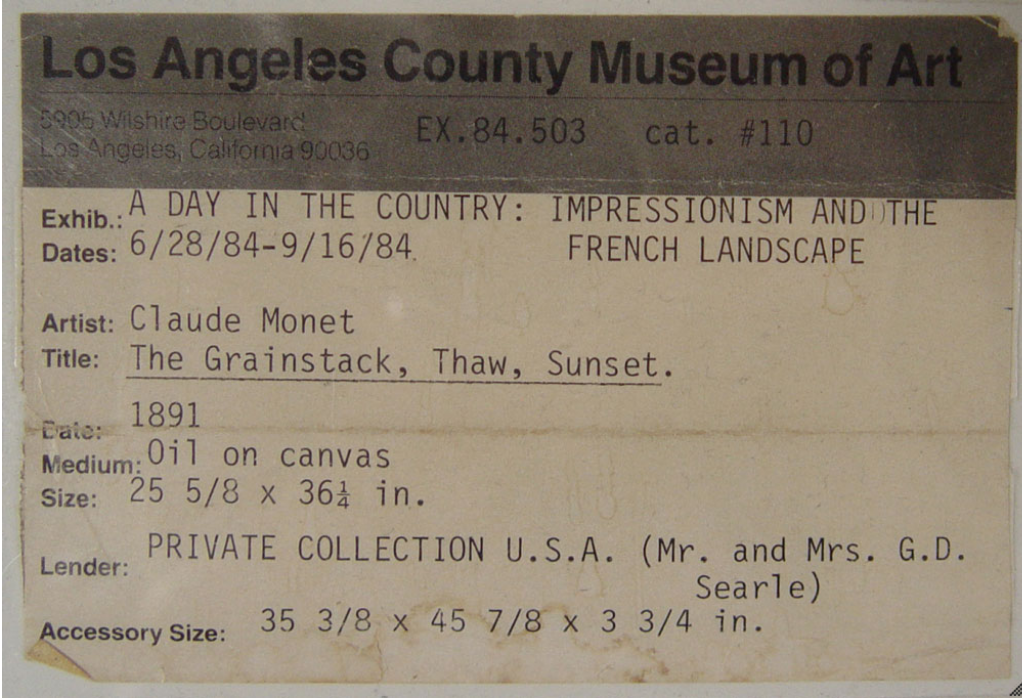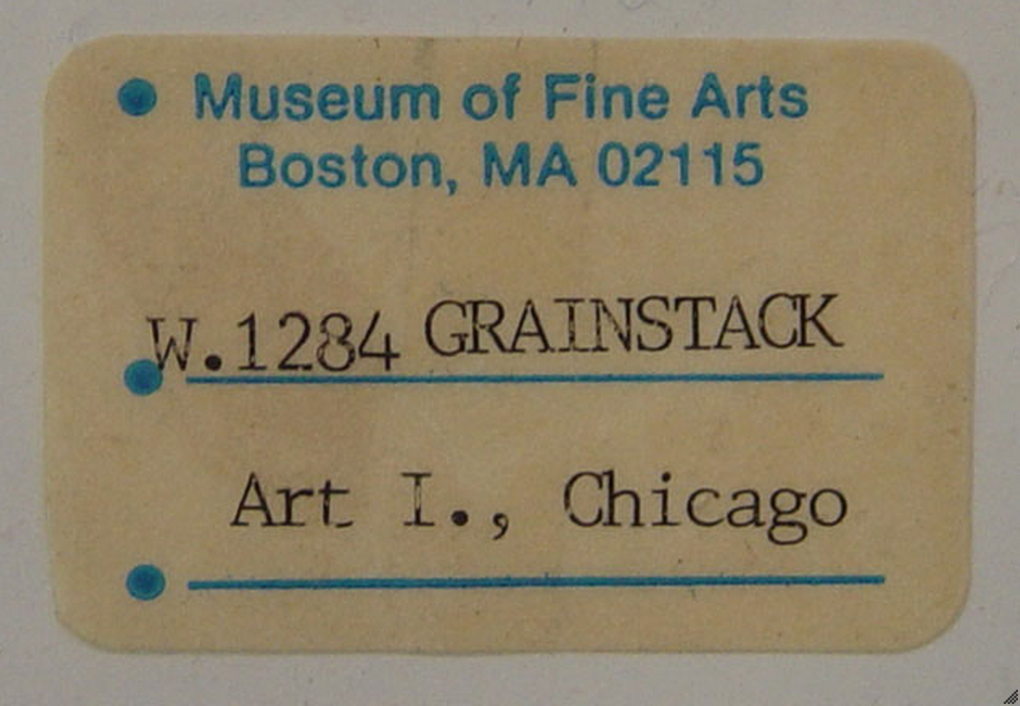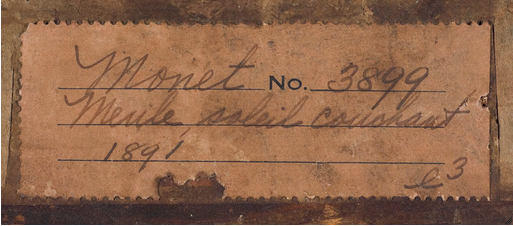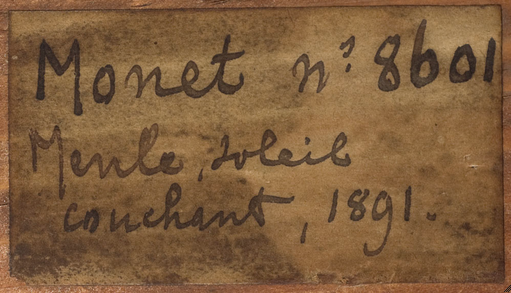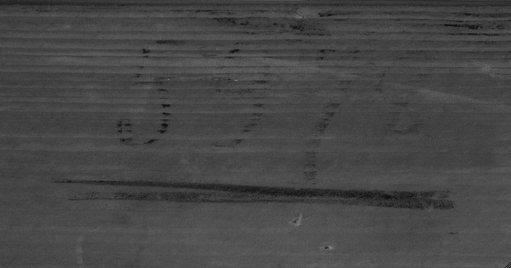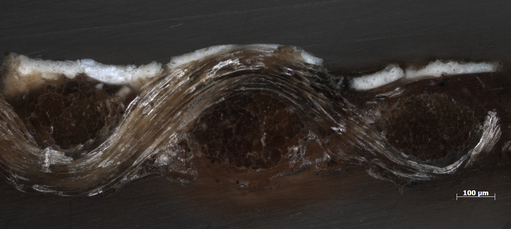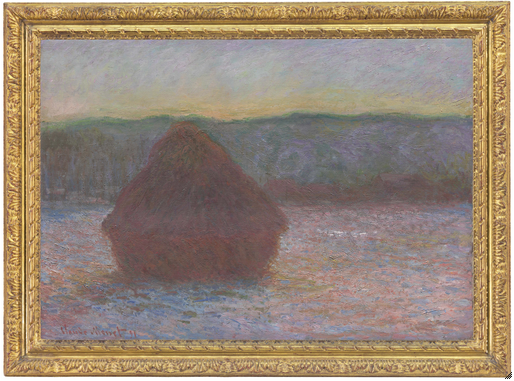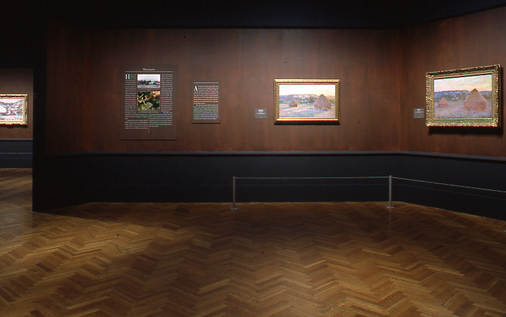Cat. 32
Stack of Wheat (Thaw, Sunset)
1890/91
Oil on canvas; 64.4 × 92.5 cm (25 3/8 × 36 7/16 in.)
Signed and dated: Claude Monet 91 (lower left, in light red paint)
The Art Institute of Chicago, gift of Mr. and Mrs. Daniel C. Searle, 1983.166
Technical Report
Technical Summary
Claude Monet’s Stack of Wheat (Thaw, Sunset) was painted on a [glossary:pre-primed], no. 30 landscape ([glossary:paysage]) standard-size linen [glossary:canvas]. The [glossary:ground] consists of a single, off-white layer. A [glossary:warp-thread match] was detected with seven other Monet paintings from the Art Institute’s collection: The Petite Creuse River (cat. 25 [W1231], inv. 1922.432), Stacks of Wheat (End of Summer) (cat. 27 [W1269], inv. 1985.1103), Stacks of Wheat (End of Day, Autumn) (cat. 28 [W1270], inv. 1933.444), Stacks of Wheat (Sunset, Snow Effect) (cat. 29 [W1278], inv. 1922.431), Sandvika, Norway (cat. 34 [W1397], inv. 1961.790), Branch of the Seine near Giverny (Mist) (cat. 36 [W1475], inv. 1933.1156), and Water Lily Pond (cat. 37 [W1628], inv. 1933.441), suggesting that the fabric for these paintings came from the same bolt of material. The artist worked from an initial [glossary:lay-in], building up the final composition in a network of open brushstrokes that includes both [glossary:wet-in-wet] and [glossary:wet-over-dry] paint application. The painting is densely worked up and includes significant compositional changes: either the stack was moved from a more central placement to its final position on the left side of the painting, or possibly two overlapping stacks were included at an earlier stage of the composition. Alterations were also made to the position of the horizon. Two small areas of bright emerald green paint exposed at the surface of the painting—one near the top of the wheat stack, the other below the building at far right—indicate that the earlier composition incorporated some bright, more colorful hues. The artist appears to have wiped or scraped localized areas of the painting when the upper layers were still relatively soft, leading to tiny areas of abrasion and interlayer [glossary:cleavage] between upper and lower paint layers and exposing the underlying layers at the surface.
Multilayer Interactive Image Viewer
The multilayer interactive image viewer is designed to facilitate the viewer’s exploration and comparison of the technical images (fig. 32.1).
Signature
Signed and dated: Claude Monet 91 (lower left, in light red paint)(fig. 32.2). The signature and date were added when the underlying paint layers were already dry (fig. 32.3).
Structure and Technique
Support
Canvas
Flax (commonly known as linen).
Standard format
The original dimensions of the painting were approximately 64 × 92 cm. This corresponds closely to a no. 30 landscape (paysage) standard-size canvas (65 × 92 cm).
Weave
[glossary:Plain weave]. Average [glossary:thread count] (standard deviation): 21.9V (0.7) x 23.6H (0.6) threads/cm; the horizontal threads were determined to correspond to the [glossary:warp] and the vertical threads to the [glossary:weft]. A warp-thread match was determined with seven other Monet paintings: The Petite Creuse River (cat. 25 [W1231], inv. 1922.432), Stacks of Wheat (End of Summer) (cat. 27 [W1269], inv. 1985.1103), Stacks of Wheat (End of Day, Autumn) (cat. 28 [W1270], inv. 1933.444), Stacks of Wheat (Sunset, Snow Effect) (cat. 29 [W1278], inv. 1922.431), Sandvika, Norway (cat. 34 [W1397], inv. 1961.790), Branch of the Seine near Giverny (Mist) (cat. 36 [W1475], inv. 1933.1156), and Water Lily Pond (cat. 37 [W1628], inv. 1933.441).
Canvas characteristics
There is mild [glossary:cusping] along the left and right edges, slightly stronger cusping along the top edge, and more pronounced cusping along the bottom edge.
Stretching
Current stretching: Dates to preacquisition [glossary:lining] (see Conservation History); tacks spaced 2.5–5 cm apart. Most of the original tack holes were reused when the canvas was restretched after lining, with additional tacks added in between (fig. 32.4). Along the left edge, there are seven old tack holes that do not correspond to the cusping. There are a few old tack holes, located at or close to the canvas edges (some torn or cut through), mainly seen on the right edge (fig. 32.5). Some additional pinholes, which pass through the canvas and into the [glossary:stretcher], appear to be more recent. A separate set of tacks (underneath the original [glossary:tacking margins]) attaches the [glossary:lining] canvas tacking edges to the stretcher (i.e., the [glossary:tacking edges] were separated after lining and tacked down separately). The lining canvas tacks are visible in the [glossary:X-ray], and the impression of the tack head is visible through the original tacking edge in places. The edges of the canvas sometimes turn over the back edge of the stretcher. Based on marks impressed in the canvas in a few places, it appears that canvas pliers were used to stretch the canvas at some point.
Original stretching: The original tack holes are spaced 5–9 cm apart; as noted above, it appears that most of the original tack holes were reused when the painting was restretched after lining (see Conservation History). The original tack holes appear to correspond to the cusping pattern on all sides.
Stretcher/strainer
Current stretcher: The current [glossary:stretcher] may be the original stretcher. The stretcher is six-membered with vertical and horizontal crossbars, and keyable [glossary:mortise and tenon joints]; all [glossary:keys] (twelve) are present. Stretcher depth: Approximately 2 cm at outer edge (inner, nonbevelled edge is closer to 2.5 cm) (fig. 32.6).
Original stretcher: See above.
Manufacturer’s/supplier’s marks
None observed in current examination or documented in previous examinations.
Preparatory Layers
Sizing
Not determined (probably glue).
Ground application/texture
The ground extends to the edges of the top, left, and right tacking margins but stops short of the bottom edge (fig. 32.7). This suggests that the canvas was cut from a larger piece of primed fabric on the top, left, and right sides; the bottom edge probably corresponds to the edge of the larger roll of canvas that was attached to the frame during priming. The canvas was probably commercially primed. The ground consists of a single layer that ranges from approximately 10 to 60 µm in thickness (fig. 32.8).
Color
The ground is off-white with some dark particles visible under magnification (fig. 32.9).
Materials/composition
Analysis indicates the presence of the following components: lead white, calcium carbonate (chalk), traces of iron oxide and bone black, silica, various silicates, and alumina. Binder: [glossary:Oil] (estimated).
Compositional Planning/Underdrawing/Painted Sketch
Extent/character
No [glossary:underdrawing] was observed with [glossary:infrared reflectography] (IRR) or microscopic examination.
Paint Layer
Application/technique and artist’s revisions
The painting was heavily worked up as evidenced by its relatively dense appearance in the X-ray. This is largely due to significant areas of compositional change and reworking, which were revealed by the technical examination (fig. 32.10). A dense buildup of brushwork to the right of the stack indicates the earlier outline of a stack further to the right. This suggests that the stack in the final painting was initially painted in a more central position and was possibly wider or more squat than in the final painting. Similar [glossary:radio-opaque] brushstrokes are also visible on the left side of the final stack. It is difficult to say whether this brushwork is associated with the earlier composition or whether it simply represents an adjustment to the left edge of the final stack in the course of painting. Given the distance between the left and right extremes of this earlier brushwork, however, it is also possible that there could have been two large, overlapping stacks in the original composition. Some adjustments were also made to the horizon line on both the left and right sides of the stack (fig. 32.11). Dense brushstrokes both above and below the final horizon seem to indicate that, at earlier stages in the painting process, the height of the horizon was altered, possibly several times (fig. 32.12).
In the execution of the final painting, the artist worked up the surface as a whole, using an open network of overlapping brushstrokes. The sky was laid in with a warm underlayer, which ranges in tone across the surface from pale orange-brown to off-white (fig. 32.13). Over this, more textural strokes of pale blue, green, pink, and yellow paint were applied, leaving both the [glossary:underpainting] and the ground layer visible in places, especially near the edges where the brushwork is more open (fig. 32.14). This underlayer does not always extend to the edges of the canvas; microscopically, it appears discontinuous in places, leaving the ground layer visible and suggesting that it was somewhat sketchy and open. The underpainting appears to have been dry when the sky was built up and the upper paint layers include both wet-in-wet and wet-over-dry paint application, indicating that the sky was carried out in more than one session. The yellow area, near the horizon, was built up with thicker strokes of paint. This was still wet in a few places when some of the strokes of green paint from the hilltops were dragged through it. In the foreground, the artist worked from dark to light, laying in the area beneath the field with dark reddish-brown (fig. 32.15, fig. 32.16), dark purple, and dull greenish-gray tones (fig. 32.17). The upper pink, peach, and blue strokes of the field were applied in both wet-in-wet and wet-over-dry layering. Final strokes of warm orange-red and yellow tones were lightly dragged across the surface, such that the brushstrokes skip over the recesses of the underlying dry paint and accentuate its surface texture (fig. 32.18). The wheat stack and the hills and buildings behind consist of fairly continuous paint applications, making it difficult to see the underlying layers. An isolated stroke of bright emerald green [glossary:impasto], near the upper-left edge of the stack and which is just exposed at the surface, suggests that some brighter, more colorful tones were used in the earlier stages of building up this area (fig. 32.19). Another small area of bright green paint from an underlying layer is visible in the area of the building farthest to the right (fig. 32.20, fig. 32.21). The buildings in this area were articulated by just a few broad brushstrokes; the only architectural detail being the very fine lines of dark green paint used to delineate the eaves of the building at far right and the pale gray highlight on the edge of its roof (fig. 32.21, fig. 32.22).
It seems that the artist rubbed or scraped over areas of the painting when the upper paint layers were set up but still relatively soft, leading to tiny areas of abrasion and interlayer cleavage that expose the lower layers at the surface of the painting (fig. 32.23). There is a band of short, vertical marks in the paint, near the top edge, approximately 1 cm wide, which occurred when the paint was still wet. This could be the result of contact from an easel cleat or some kind of transporting device. In some areas, final strokes from the sky pass over these marks (fig. 32.24), indicating that they occurred while the artist was still working on the painting. Several light gouges were observed throughout the paint surface. These probably occurred as a result of handling when the paint was still soft. There are several brush hairs embedded in the paint surface, as well as tiny bubble holes where the paint was more thickly applied or more heavily worked. Two unidentified inclusions in the paint layer were observed near the bottom right edge (fig. 32.25, fig. 32.26). These ridged, reddish-brown, shell-shaped objects measure approximately 2 mm in diameter and are probably composed of organic material (they appear relatively radio transparent in the X-ray). They could be plant-related materials that were incorporated into the paint layer when it was wet. There is some flattened impasto around the edges of the painting, presumably due to framing while the paint was still soft.
Painting tools
Brushes including 1.0 cm, flat ferrule (based on width and shape of brushstrokes).
Palette
[glossary:XRF] analysis indicates the presence of the following [glossary:pigments]: lead white, cobalt blue, viridian, emerald green, cadmium yellow, one or more iron oxide pigments, vermilion. [glossary:UV fluorescence] of several pale-pink paint strokes suggests the use of red lake throughout the landscape. Restoration fills and [glossary:retouching] appear to contain titanium white and zinc white (not present in the original paint layers), and calcium compounds at higher levels than those detected in the original paint. Naples yellow and strontium yellow also appear to be associated exclusively with areas of retouching.
Binding media
Oil (estimated).
Surface Finish
Varnish layer/media
The painting was cleaned in 1996 and left unvarnished (see Conservation History). The paint surface has a relatively dry, matte quality in most areas, with some subtle variations in surface sheen depending on the qualities of the paint application.
Conservation History
The painting was lined with an aqueous adhesive at some point before it was acquired in 1983. The lining, which may have preserved the original stretcher, appears to date to the early twentieth century, based on its aged appearance. The original tacking margins were preserved; those of the lining canvas were trimmed, disguising the presence of the lining canvas at the edges. The presence of a synthetic varnish at the time of acquisition suggests that other treatments (i.e., [glossary:varnish] removal and revarnishing) were carried out before the painting was acquired.
There are microscopic traces of retouching in localized areas consisting of a coarse, granular, greenish-gray fill material. This fill material is often associated with traces of retouching that appear to have been mostly removed in previous cleaning. Apart from a few actual small damages to the paint layer, as seen in the area of the signature and date, for example (fig. 32.27), most of these fills seem to be unrelated to actual paint loss. This is evident throughout the field area, where the fill material covers tiny areas of the dark brown underpainting exposed at breaks in the upper brushwork (fig. 32.28). The filling and retouching was probably done either for aesthetic reasons (i.e., to reduce the appearance of the brown underpainting) or because these areas were interpreted as losses in the upper paint layers (i.e., exposing more of the underpainting than the artist originally intended to be seen). To the right of the stack, where there are numerous small areas of exposed brown underpainting, there is a relatively concentrated area of the fill material. Some of these areas may exhibit tiny flake losses in the upper paint layers, but for the most part the fill was applied in areas where the dark brown underlayer was originally left more visible. In the background of the composition, there is a campaign of more broadly applied (and perhaps inventive) retouching that appears to cover well-preserved original paint. The retouching is very thinly applied using a lean, matte paint, which, microscopically, has a granular appearance. It is visible in the lighter strokes on the roof of the building farthest to the right, as well as in the area in front of the building (fig. 32.29) and in the vertical, linear “trees” to the right of the stack. In this area, the retouching is slightly glossier but still consists of thin, dilute paint with coarse particles. In the yellow area of the sky, near the middle of the horizon, residues of pale yellow retouching are visible microscopically (fig. 32.30). It is possible that there was some abrasion in this area, but this seems to be related to the artist’s wiping or scraping technique (see Application/technique) rather than the result of overcleaning. In general, the original paint layer is intact underneath. XRF analysis indicated the presence of titanium white in all of the areas of restoration analyzed, which would date the restoration to some time after 1920 (see Palette). The retouching is not visually disturbing and is for the most part visible only under magnification.
In 1996, a [glossary:synthetic varnish layer] was removed. This revealed old blanched varnish residues in the interstices of the impasto in the stack and in the hills in the center of the composition, which were removed with solvent. The earlier restorations were not removed.
Condition Summary
The work is in good condition. The canvas is lined with an aqueous adhesive and stretched taut with no planar deformations. The original tacking margins are intact, and the work appears to retain its original stretcher. The paint layer is secure. In places, the impasto is slightly flattened and moated, likely as a result of the lining process. There are small areas of damage and paint loss around the signature and date and in a few places along the bottom edge. These areas were restored (probably at an early date) using a generic coarse, greenish-gray fill material. In general, the retouching, which remains most visibly in the signature (cross of t) and date (top of 1), appears to have been mostly removed, probably in subsequent cleanings, with only traces visible in some areas under the microscope. Additional localized areas of the same fill (with only traces of retouching) are visible microscopically throughout the foreground. These are unrelated to damage and appear to have been applied to block out areas of the dark brown underpainting that had originally been left visible through breaks in the brushwork. A more liberal campaign of retouching over well-preserved original paint appears to have been carried out in the area of the buildings, hills, and sky on the right side of the stack. The retouching paint is thinly applied and appears granular, lean, and matte. The [glossary:inpainting] of a loss near the right side of the group of hills, just above the buildings, appears somewhat mismatched. There is a general network of light, mechanical cracks, with localized areas of [glossary:drying cracks] within the stack. Gold residues from the frame are present along the top and bottom edges, and there are some accretions in the upper-right corner of the painting. Yellowed varnish residues are visible in the recesses of the paint texture. The work is currently unvarnished and has a dry, matte surface with subtle variations in gloss depending on the qualities of the paint.
Kimberley Muir
Frame
Current frame (installed in 1995): The frame is not original to the painting. It is a reproduction of a Louis XIII convex frame with carved alternating acanthus and stylized leaves, plain hollow, and continuous ribbon bordered by a leaf-tip sight molding (Paul Mitchell Ltd., London 1995). The frame is water gilded over red bole on gesso. The hollow is burnished, with selective burnishing and a heavier rub on the carved ornament. The toning is heavy with final washes of umber and gray with dark flecking. The carved jelutong molding is mitered and joined with angled dovetail splines. The molding from perimeter to interior, is fillet; ogee cyma recta side; convex face with carved alternating acanthus and stylized leaves; hollow; torus carved with continuous ribbon; and cove with carved leaf-tip sight molding (fig. 32.31).
Previous frame (installed by 1983; removed in 1995): The work was previously housed in a reproduction Louis XV frame, gilt, with swept sides and foliate rocaille cartouches with fleur-de-lis centers.
Kirk Vuillemot
Provenance
Possibly sold by the artist to Hamman, Paris, as agent for Knoedler and Company, New York, Sept. 1891.
Sold at the Knoedler, New York, sale, Chickering Hall, New York, Apr. 11, 1893, lot 77, to Durand-Ruel, New York, and Boussod, Valadon et Cie., Paris, in half-shares, for 6,000 francs.
Half share sold by Durand-Ruel, New York, to Durand-Ruel, Paris, Sept. 30, 1899 or Nov. 13, 1899.
Half share sold by Durand-Ruel, Paris, to Boussod, Valadon et Cie., Paris, May 27, 1903.
Acquired by Rosenberg, Paris, 1903.
Sold by Rosenberg, Paris, to Durand-Ruel, Paris, Jan. 11, 1908.
Sold by Durand-Ruel, Paris, to Durand-Ruel, New York, Nov. 11, 1915 or Dec. 9, 1915.
Sold by Durand-Ruel, New York, to André Weil, Paris, Jan. 9, 1948.
Acquired by Wildenstein, New York and Paris, by 1982.
Sold by Wildenstein, New York and Paris, to Mrs. Mercedes Eraso de Rodríguez Landaeta, Caracas, Venezuela, by 1982.
Acquired by Rachel Adler Fine Art, New York, by Aug. 1982.
Sold by Rachel Adler Fine Art, New York, to James Goodman Gallery, New York, Aug. 1982.
Sold by James Goodman Gallery, New York, to Stephen Hahn Gallery, New York, Feb. 7, 1983.
Half share sold by Stephen Hahn Gallery, New York, to Acquavella Galleries, New York, Feb. 7, 1983.
Sold by Acquavella Galleries, New York, to Mr. Daniel C. Searle, Winnetka, Ill., Feb. 7, 1983.
Given by Mr. and Mrs. Daniel C. Searle, Winnetka, Ill., to the Art Institute of Chicago, beginning in 1983.
Exhibition History
Possibly Paris, Galeries Durand-Ruel, Exposition d’oeuvres récentes de Claude Monet, May 1891, cat. 12, as Meule. (Fin du jour.).
New York, Fine Arts Society Building, Loan Exhibition, Feb. 1893, cat. 41, as The Haystack —Thaw. Lent by Mr. M. Knoedler.
New York, Durand-Ruel Galleries, Exposition of Forty Paintings by Claude Monet, Jan. 12–27, 1895, cat. 44, as “Meule—Dégel—Soleil couchant.” 1891.
Boston, St. Botolph Club, Exhibition of Paintings by Claude Monet, Feb. 4–16, 1895, cat. 11, as Meule. Le Degel. Soleil couchant. 1891.
Munich, Kunstausstellungsgebäude, Internationalen Kunst-Ausstellung: Secession, 1900, cat. 195, as Heuschober. Untergehende Sonne.
Berlin, Paul Cassirer, XI. Jahrgang. VI Ausstellung, Jan. 22–Feb. 22, 1909, cat. 8, as Heuschober bei Sonnenuntergang.
Copenhagen, Musée Royal de Copenhague, Exposition d’art français du XIXe siècle, May 15–June 30, 1914, cat. 149, as Höstak. Solnedgant.—Meule: soleil couchant (1891). Galeries Durand-Ruel.
Possibly Paris, Galeries Durand-Ruel, Tableaux par Claude Monet, Mar. 2–28, 1914, cat. 43, as Meules, soleil couchant. 1891.
Arts Club of Chicago, Paintings by Cl. Monet in Retrospect 1868–1913, Jan. 6–31, 1933, cat. 11.
Los Angeles County Museum of Art, A Day in the Country: Impressionism and the French Landscape, June 28–Sept. 16, 1984, cat. 110 (ill.); Art Institute of Chicago, Oct. 23, 1984–Jan. 6, 1985; Paris, Galeries Nationales, Grand Palais, as L’impressionnisme et le paysage français, Feb. 4–Apr. 22, 1985 (Los Angeles and Chicago only).
Boston, Museum of Fine Arts, Monet in the ’90s: The Series Paintings, Feb. 7–Apr. 29, 1990, cat. 28 (ill.); Art Institute of Chicago, May 19–Aug. 12, 1990; London, Royal Academy of Arts, Sept. 7–Dec. 9, 1990.
Art Institute of Chicago, Claude Monet, 1840–1926, July 22–Nov. 26, 1995, cat. 100 (ill.). (fig. 32.32)
Moscow, State Pushkin Museum of Fine Arts, Klod Mone [Claude Monet], Nov. 26, 2001–Feb. 21, 2002, cat. 31 (ill.); Saint Petersburg, State Hermitage Museum, May 1–15, 2002.
Fort Worth, Tex., Kimbell Art Museum, The Impressionists: Master Paintings from the Art Institute of Chicago, June 29–Nov. 2, 2008, cat. 80 (ill.).
Selected References
Possibly Galeries Durand-Ruel, Paris, Exposition Claude Monet, exh. cat. (Galeries Durand-Ruel, 1891), p. 16, cat. 12.
Fine Arts Society, Catalogue: Loan Exhibition, exh. cat. (Fine Arts Society, [1893]), p. 39, cat. 41.
Durand-Ruel Galleries, New York, Exposition of Forty Paintings by Claude Monet, exh. cat. (Durand-Ruel, 1895), cat. 44.
St. Botolph Club, Boston, Exhibition of Paintings by Claude Monet, exh. cat. (St. Botolph Club, 1895), cat. 11.
Offizieller Katalog der Internationalen Kunst-Ausstellung des Vereins bildender Künstler Münchens (E. V.), “Secession” 1900, exh. cat. (F. Bruckmann, [1900]), p. 22, cat. 195.
Karl Voll, “Die Internationale Kunstausstellung 1900 der Münchener Secession,” Die Kunst für Alle: Malerei, Plastik, Graphik, Architektur 15, 21 (Aug. 1, 1900), p. 485.
Possibly Galeries Durand-Ruel, Paris, Tableaux par Claude Monet, exh. cat. (Galeries Durand-Ruel, 1914), cat. 43.
Musée Royal de Copenhague, Exposition d’art français du XIXe siècle, exh. cat. (Dansk Kunstmuseums Forening, 1914), p. 37, cat. 149.
Gustave Geffroy, Claude Monet, sa vie, son temps, son oeuvre (Paris, 1922), opp. p. 240 (ill.).
Oscar Reuterswärd, Monet: En konstnärshistorik (Bonniers, 1948), p. 193, fig. 90.
Daniel Wildenstein, Claude Monet: Biographie et catalogue raisonné, vol. 3, Peintures, 1887–1898 (Bibliothèque des Arts, 1979), pp. 38; 142; 143, cat. 1284 (ill.).
Daniel Wildenstein, Claude Monet: Biographie et catalogue raisonné, vol. 4, Peintures, 1899–1926 (Bibliothèque des Arts, 1979), p. 79, n. 726 (cat. 1284).
Art Institute of Chicago, “Acquisitions,” Mosaic (July–Aug. 1983), p. 8 (ill.).
Art Institute of Chicago, Art Institute of Chicago Annual Report 1982-83 (Art Institute of Chicago, 1983), pp. 5, fig. 6; 12.
Art Institute of Chicago, A Record of Sharing with Chicago’s Masterpiece, annual report supplement (Art Institute of Chicago, [1983]), p. 15 (ill.).
Robert Gordon and Andrew Forge, Monet (Abrams, 1983), pp. 161 (ill.), 163.
“French Paintings Recently Acquired by the Art Institute of Chicago,” Burlington Magazine 76, 976 (July 1984), p. 465, fig. 91.
Art Institute of Chicago, Art Institute of Chicago Museum Studies, 11, 1 (Fall 1984), front cover (detail), p. 2.
Richard R. Brettell, “Monet’s Haystacks Reconsidered,” Art Institute of Chicago Museum Studies 11, 1 (Fall 1984), pp. 4–5, pl. 1; 6; 7; 12; 16–17, fig. 12 (ill.); 19; 21, n. 6.
Andrea P. A. Belloli, ed., A Day in the Country: Impressionism and the French Landscape, exh. cat. (Los Angeles County Museum of Art, 1984), p. 365.
Richard R. Brettell, “The Fields of France,” in A Day in the Country: Impressionism and the French Landscape, ed. Andrea P. A. Belloli, exh. cat. (Los Angeles County Museum of Art, 1984), pp. 246; 260–262; 269, no. 110 (ill.).
Richard R. Brettell, “La champagne française,” in Réunion des Musées Nationaux, L’impressionnisme et le paysage français, exh. cat. (Réunion des Musées Nationaux, 1985), pp. 261; 278; 282–291, no. 110 (ill.).
Richard R. Brettell, Post-Impressionists (Art Institute of Chicago, 1987), pp. 35, 38 (ill.); 118.
Paul Hayes Tucker, Monet in the ’90s: The Series Paintings, exh. cat. (Museum of Fine Arts, Boston/Yale University Press, 1989), pp. 3; 77; 81; 88, pl. 27; 296, cat. 28.
Martha Kapos, ed., The Impressionists: A Retrospective (Hugh Lauter Levin/Macmillan, 1991), p. 311, pl. 101.
Sylvie Patin, Monet: “Un oeil . . . mais, bon Dieu, quel oeil!” (Gallimard/Réunion des Musées Nationaux, 1991), pp. 104 (ill.), 105 (detail), 172. Translated by Anthony Roberts as Monet: The Ultimate Impressionist (Abrams, 1993), pp. 104 (ill.), 105 (detail), 171.
Anne Rorimer, “The Date Paintings of On Kawara,” Art Institute of Chicago Museum Studies 17, 2 (1991), p. 122, fig. 2.
John Sallis, “Monet’s Grainstacks: Shades of Time,” Tema Celeste International Art Magazine 30 (Mar.- Apr. 1991), pp. 58 (ill.); 67, n. 13.
Daniel Wildenstein, Claude Monet: Catalogue raisonné, vol. 5, Supplément aux peintures: Dessins; Pastels; Index (Wildenstein Institute, 1991), pp. 48, cat. 1284; 200, letters 2833, 2835–2837.
Richard Shiff, “‘Il faut que les yeux soient émus’: Impressionisme et symbolism vers 1891,” Revue de l’art 96 (1992), p. 27, fig. 3.
Andrew Forge, Monet, Artists in Focus (Art Institute of Chicago, 1995), pp. 44; 49; 90, pl. 19; 108.
Charles F. Stuckey, with the assistance of Sophia Shaw, Claude Monet, 1840–1926, exh. cat. (Art Institute of Chicago/Thames & Hudson, 1995), pp. 121, cat. 100 (ill.); 226; 227; 245.
Daniel Wildenstein, Monet, or The Triumph of Impressionism, cat. rais., vol. 1 (Taschen/Wildenstein Institute, 1996), pp. 274–75, cat. 1284 (ill.); 275.
Daniel Wildenstein, Monet: Catalogue raisonné/Werkverzeichnis, vol. 3, Nos. 969–1595 (Taschen/Wildenstein Institute, 1996), pp. 495, cat. 1284 (ill.); 501.
John Sallis, Shades—Of Painting at the Limit (Indiana University Press, 1998), n. pag., pl. 11; 54–55.
T. J. Clark, Farewell to an Idea: Episodes from a History of Modernism (Yale University Press, 1999), pp. 76; 110, fig. 57; 111.
Art Institute of Chicago, Impressionism and Post-Impressionism in the Art Institute of Chicago, selected by James N. Wood (Art Institute of Chicago/Hudson Hills, 2000), pp. 134–35 (ill.).
A. G. Kostenevich, Klod Mone [Claude Monet], exh. cat. (Khudozhnik i Kniga, 2001), pp. 84, cat. 31 (ill.); 85 (detail).
Richard R. Brettell, From Monet to Van Gogh: A History of Impressionism, vol. 2 (Teaching Co., 2002), pp. 161, 167, 183.
Debra N. Mancoff, Monet: Nature into Art (Publications International, 2003), pp. 11 (ill.), 78–79 (ill.), 128.
Anna Gruetzner Robins, “‘Slabs of Pink and Lumps of Brown’: The Critical Reaction to the Exhibition of a Monet Grainstack Painting in Britain in 1893,” in Monet and French Landscape: Vétheuil and Normandy, ed. Frances Fowle (National Galleries of Scotland, 2006), pp. 159; 168, n. 10.
Charles F. Stuckey, “The Predications and Implications of Monet’s Series,” in The Repeating Image: Multiples in French Painting from David to Matisse, ed. Eik Kahng, exh. cat. (Walters Art Museum/Yale University Press, 2007), pp. 85; 87–88, fig. 5.
Eric M. Zafran, “Monet in America,” in Wildenstein and Co., Claude Monet (1840–1926): A Tribute to Daniel Wildenstein and Katia Granoff, exh. cat. (Wildenstein, 2007), p. 104.
Gloria Groom and Douglas Druick, with the assistance of Dorota Chudzicka and Jill Shaw, The Impressionists: Master Paintings from the Art Institute of Chicago, exh. cat. (Art Institute of Chicago/Kimbell Art Museum, 2008), pp. 21 (ill.), 22; 103; 108; 156; 159, cat. 80 (ill.). Simultaneously published as Gloria Groom and Douglas Druick, with the assistance of Dorota Chudzicka and Jill Shaw, The Age of Impressionism at the Art Institute of Chicago (Art Institute of Chicago/Yale University Press, 2008), pp. 21 (ill.), 22; 103; 108; 156; 159, cat. 80 (ill.).
Other Documentation
Documentation from the Durand-Ruel Archives
Inventory number
Stock Durand-Ruel New York 1060
Durand-Ruel, New York, stock books 1888–1893 and stock book 1894–1905
Inventory number
Stock Durand-Ruel Paris 5503
Durand-Ruel, Paris, stock book 1901–13
Inventory number
Stock Durand-Ruel Paris 8601
Durand-Ruel, Paris, stock books 1901–1913 and 1912–21
Inventory number
Stock Durand-Ruel New York 3899
Durand-Ruel, New York, stock books 1904–1924 and 1949
Photograph number
Durand-Ruel Paris photo no. 5978
Other Documents
Label (fig. 32.33)
Label (fig. 32.34)
Inscription (fig. 32.35)
Inscription (fig. 32.36)
Labels and Inscriptions
Undated
Label
Location: stretcher
Method: residue of paper label with some handwritten script
Content: [illegible] (fig. 32.37)
Label
Location: stretcher
Method: handwritten label
Content: Monet no 8601 / Meule, soleil / couchant, 1891. (fig. 32.38)
Number
Location: stretcher
Method: handwritten
Content: 5957 (fig. 32.39)
Number
Location: stretcher
Method: handwritten
Content: 5978 (fig. 32.40)
Inscription
Location: stretcher
Method: handwritten
Content: C9[?] (fig. 32.41)
Number
Location: stretcher
Method: handwritten
Content: 12 (fig. 32.42)
Inscription
Location: stretcher
Method: handwritten
Content: [illegible] (fig. 32.43)
Inscription
Location: previous frame; transcription in conservation file
Method: handwritten in red
Content: – MELT – TOP (fig. 32.44)
Pre-1980
Label
Location: stretcher
Method: printed label with handwritten script
Content: Monet No. 3899 / Meule, soleil couchant / 1891 / e[or l?]3 (fig. 32.45)
Post-1980
Inscription
Location: stretcher
Method: handwritten
Content: DR 8601 (fig. 32.46)
Label
Location: backing board
Method: printed label
Content: THE ART INSTITUTE OF CHICAGO / ARTIST: Claude Monet / TITLE: Stacks of Wheat (Thaw, Sunset) (1890–91) / MEDIUM: Oil on canvas / CREDIT: Gift of Mr. and Mrs. Daniel C. Searle / ACC.#: 1983.166 (fig. 32.47)
Label
Location: backing board
Method: printed label
Content: Los Angeles County Museum of Art / 5905 Wilshire Boulevard / Los Angeles, California 90036 / EX.84.503 cat. #110 / Exhib.: A DAY IN THE COUNTRY: IMPRESSIONISM AND THE / FRENCH LANDSCAPE / Dates: 6/28/84–9/16/84 / Artist: Claude Monet / Title: The Grainstack, Thaw, Sunset. / Date: 1891 / Medium: Oil on canvas / Size: 25 5/8 × 36 1/4 in. / Lender: PRIVATE COLLECTION U.S.A. (Mr. and Mrs. G.D. / Searle) / Accessory Size: 35 3/8 × 45 7/8 × 3 3/4 in. (fig. 32.48)
Label
Location: backing board
Method: printed label with typewritten script
Content: Museum of Fine Arts / Boston, MA 02115 / W.1284 GRAINSTACK / Art I., Chicago (fig. 32.49)
Number
Location: stretcher
Method: handwritten script on brown paper
Content: 1983.16[6] (fig. 32.50)
Examination and Analysis Techniques
X-radiography
Westinghouse X-ray unit, scanned on Epson Expressions 10000XL flatbed scanner. Scans digitally composited by Robert G. Erdmann, University of Arizona.
Infrared Reflectography
Goodrich/Sensors Unlimited SU640SDV-1.7RT with H filter (1.1–1.4 µm) and J filter (1.5–1.7 µm); Inframetrics Infracam with 1.5–1.73 µm filter; Fujifilm S5 Pro with X-Nite 1000B/2 mm filter (1.0–1.1 µm).
Visible Light
Natural-light, raking-light, and transmitted-light overalls, and macrophotography: Fujifilm S5 Pro with X-NiteCC1 filter.
Ultraviolet
Fujifilm S5 Pro with X-NiteCC1 filter and Kodak Wratten 2E filter.
High-Resolution Visible Light (and Ultraviolet)
Sinar P3 camera with Sinarback eVolution 75 H (PECA 918 UV/IR interference cut filter and Kodak Wratten 2E filter).
Microscopy and Photomicrographs
Sample and [glossary:cross-sectional analysis] using a Zeiss Axioplan 2 research microscope equipped with reflected light/UV fluorescence and a Zeiss AxioCam MRc5 digital camera. Types of illumination used: [glossary:darkfield], differential interference contrast ([glossary:DIC]), and [glossary:UV]. In situ photomicrographs with a Wild Heerbrugg M7A StereoZoom microscope fitted with an Olympus DP71 microscope digital camera.
X-ray Fluorescence Spectroscopy (XRF)
Several spots on the painting were analyzed in situ with a Bruker/Keymaster TRACeR III-V with rhodium tube.
Polarized Light Microscopy (PLM)
Zeiss Universal research microscope.
Scanning Electron Microscopy/Energy-Dispersive X-ray Spectroscopy (SEM/EDX)
[glossary:Cross sections] analyzed after carbon coating with a Hitachi S-3400N-II VP-SEM with an Oxford EDS and a Hitachi solid-state [glossary:BSE] detector. Analysis was performed at the Northwestern University Atomic and Nanoscale Characterization Experimental (NUANCE) Center, Electron Probe Instrumentation Center (EPIC) facility.
Automated Thread Counting
Thread count and [glossary:weave] information were determined by Thread Count Automation Project software.
Image Registration Software
Overlay images registered using a novel image-based algorithm developed by Damon M. Conover (GW), John K. Delaney (GW, NGA), and Murray H. Loew (GW) of the George Washington University’s School of Engineering and Applied Science and the National Gallery of Art, Washington, D.C.
Image Inventory
The image inventory compiles records of all known images of the artwork on file in the Conservation Department, the Imaging Department, and the Department of Medieval to Modern European Painting and Sculpture at the Art Institute of Chicago (fig. 32.51).


